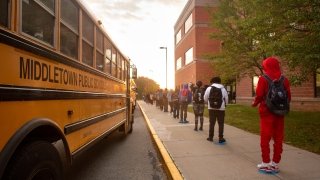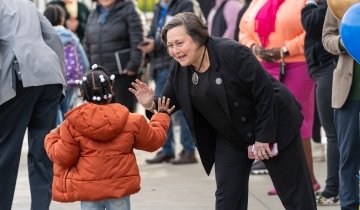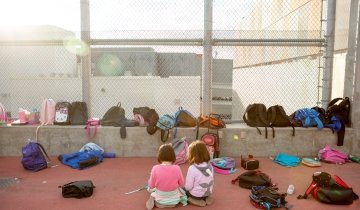Teacher shortages, waning enrollment and growing civil unrest: these are but a few of the challenges facing school districts today. A new study examining the first 14 months of the pandemic provides insights into the origins of these current challenges and also offers in-depth understanding of the real-time challenges districts faced in 2020-21 to provide students access to an education and other necessities during an unprecedented pandemic.
How did California school districts rise to the occasion? A new report by lead author Julie A. Marsh, professor of education policy in the USC Rossier School of Education and co-director of the USC Center on Education Policy, Equity and Governance, examined how seven unnamed districts in the Golden State served their communities during the first 14 months of the pandemic. This period coincided with worldwide protests against racial injustice after Minneapolis police murdered George Floyd in May 2020. The massive demonstrations meant that school districts were not only expected to meet the challenges introduced by COVID-19 but also to address systemic racism as well.
“What we were hearing from people across these districts, despite them being quite different in a lot of respects, is that they responded in very similar ways during this early pandemic period,” Marsh said. “They all talked about early coping strategies of just addressing the hierarchy of needs, meaning what were the most central things that mattered for students and families.”
Crisis Response in California School Districts: Leadership, Partnership and Community, published by the Stanford Graduate School of Education’s Policy Analysis for California Education, found that partnerships with community, labor and board leaders helped schools serve the complex needs of students and families during this tumultuous period. The researchers began tracking seven districts, varying in size, location and grade range, via the internet and social media starting in March 2020, and later adding interviews, finding that the school systems quickly suspended in-person instruction to protect students and staff.
Almost immediately, the districts purchased personal protective equipment and implemented safety measures. Air filtration systems were later updated. District leaders also ensured that students and, often, their family members, had access to school meals. Giving students access to technology, including laptops and hotspots, was another major priority for the districts early on.
Rudolph Crew, a USC Rossier professor of clinical education and former chancellor of New York City Public Schools, said that navigating the novel coronavirus is not comparable to implementing a program to alleviate certain conditions at a public school. He said that it entails maintaining the structure of school using an “entirely different array of tools” while giving people hope and reassurance “that each day would end up being safer and better the next day.”
“That’s a very, very, very delicate, intricate piece of work,” Crew said. “Julie’s report, in these seven cases, she’s…captured that extraordinarily well.”
As the coronavirus crisis continued, districts also made efforts to meet the mental health of students, personnel and families, providing access to teletherapy and wellness centers.
“People started realizing the real trauma that some families had been facing, and also the kind of exhaustion that the adults in schools were facing, so that became big,” Marsh said.
Just two months after the first pandemic lockdowns began, George Floyd was killed. The urban and suburban school districts that the researchers studied recognized the hurt and outrage that followed Floyd’s death. They released statements in support of their African American students and other youth of color and organized trainings and committees focused on systemic racism. In rural districts, though, some district officials resisted addressing Floyd’s death.
“We heard folks telling us that there really wasn't an issue for them to be addressing, that because, in one case, most of the community was white, they didn't necessarily think they needed to address it,” Marsh said. “There was a sense in the rural districts that individuals were very uncomfortable talking about issues of racism.”
The districts may not have all agreed on the best approach to discuss racial injustice but they all emphasized the importance of relationships in times of crisis. Superintendents got personal with the communities they serve, at times passing out computer devices and meals directly to students and their families.
“For me, it’s not surprising,” Crew said of the superintendents’ behavior. “I’ve always known that that was the capability of folks who do this work. I think people just don't realize the value proposition that they bring to building community and sustaining a quality life through schooling. The pandemic … made people see that, wow, teachers, principals and superintendents do more than most people give him credit for.”
School boards also stood out during the pandemic. To understand the needs and concerns of students and parents, board members listened to their communities. They used surveys, advisory committees and community-based organizations to engage the public as well as call centers, reopening committees and site councils. Districts also partnered with local organizations to set up learning hubs with on-site supervision for youth engaged in remote instruction.
At the same time, COVID-19 tested relationships between districts and their teacher unions. School personnel experienced burnout performing their jobs amid the pandemic and a polarizing political climate. In the end, district officials who communicated with their unions transparently, engaged them in policy and worked with them to meet student needs made strong decisions during COVID-19, the study found.
As the pandemic wore on, districts grew frustrated with what they considered to be inconsistent state guidance. School officials complained that the state left health-related decisions around closing and reopening schools to local leaders instead of taking responsibility and making these calls. On the other hand, school districts were grateful that county public health department leaders issued guidance about the pandemic to them, including setting benchmarks about when community spread of COVID-19 reached levels dangerous enough for schools to close.
Despite school districts’ best efforts, they faced unrelenting pressures during the pandemic, including from parents and personnel who disagreed about whether to reopen schools for in-person learning, require masks and take other safety measures. Some school districts also could not overcome challenges related to the digital divide among their students. Improving this issue requires intervention from local, state or federal government officials.
“There’s a broader set of infrastructure limitations that made it harder and strained districts in their ability to respond,” Marsh said. “They couldn't overcome the fact that there were certain areas that just simply did not get WiFi access. They could try to do hotspots, but they really needed some higher-level action to have universal access, health and human services and housing, for example.”
Two-and-a-half years after the first COVID-19 lockdowns began, the challenges school districts face continue. The study authors suggest that a number of policies could help schools during what remains a stressful time. These policies include stabilizing state funding for schools and strategizing around teacher and staff shortages. The state should also take action to provide robust social welfare to communities, including public and mental health services and food security, broadband access, employment and affordable housing programs.
“Now what the policy is going to have to do is begin to point to the post-pandemic era where we start to really pay attention to gaps that were made evermore obvious by virtue of the pandemic—equity, distribution, funding, information and data gaps,” Crew said. “I think we're going to have to pay a lot of attention to the partnerships that, in fact, came together by virtue of the pandemic. We want to institutionalize those kinds of partnerships as a natural and normal part of the school day or school experience, particularly in the most marginalized communities.”
Finally, the researchers recommend that the state help districts overcome the “steady drumbeat of disinformation” about COVID-19 protocols and school curricula, which has led to book bans and limits on the teaching of race, gender and related topics.
“The kind of polarization that we kept seeing emerge out of the early phases of this points to the need for building broader support for public education,” Marsh said. “How do we ensure that we have better information, more civil discourse in our meetings and our board meetings? The state could play a role in providing some real targeted support for districts to counter the ugly politics and disinformation that’s out there.”






